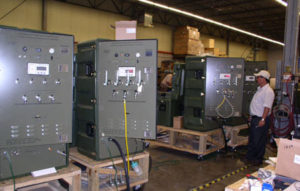Consider These Factors When Purchasing an Oxygen Generator

Oxygen generators have a range of applications, from providing vital life support to medical patients, to aerating wastewater, promoting biological treatment, boosting the yield of gold mines, and helping hatchery trout thrive. On Site Gas Systems offers a comprehensive range of top-quality oxygen generators for a wide variety of purposes.
Whether for commercial, industrial, or medical situations, On Site Gas PSA oxygen generators benefit commercial operations from fish farms to glassblowing; supply oxygen for healthcare purposes (including field-ready portable generators), and serve astronauts aboard the International Space Station. In addition to our ready-to-go turnkey generators, we also design custom oxygen-generation systems for nearly any setting or purpose.
Our systems utilize Pressure Swing Adsorption (PSA) technology. These state-of-the-art PSA generators pass compressed air through a vessel containing zeolite, a molecular-level sieve that filters out nitrogen to provide high-purity oxygen.
Oxygen Purity
What level of oxygen purity do you require? At On Site Gas, our standard-purity generators deliver up to 95% oxygen for many commercial purposes, and our industrial generators provides up to the 99% level required by many industrial applications along with hospitals, clinics, and healthcare providers.* (Our generators produce 99% oxygen by running a 95% concentration through a couple of other processing stages.)
Oxygen Flow and Pressure
Calculate the minimum required flow – in standard cubic feet per hour (SCFH), normal cubic meters per hour (NM3/H), liters per minute (LPM), or whatever other units – for your purposes, as well as the necessary delivery pressure to determine what sort of oxygen-generating setup you require.
If you use a generator to fill oxygen cylinders, account for the influence of cylinder consumption on your flow requirements. Speaking of, at On Site Gas we also provide high-power oxygen filling stations for efficiently stocking your cylinders with 93%, 95%, or 99% oxygen.
Capacity of Your Air Compressor
At the front end of things, can the capacity of your compressed-air unit support the oxygen generator you’re considering?
Oxygen Generator Footprint and Setting
Consider the total footprint of your oxygen-generation system, including the generator, air compressor and any associated tanks or cylinders. Identify a location with the size and infrastructural needs to accommodate it.
Please don’t hesitate to contact us at On Site Gas to meet any of your oxygen-generating requirements. Whether it’s a self-contained portable unit for a frontline hospital or a custom-built industrial installation, we’ve got the oxygen generators you need.
*If you need an oxygen generator for medical purposes, it’s essential to familiarize yourself with local regulations.




